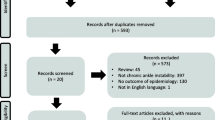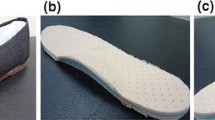Abstract
The goal of this study was to approach ankle instability by measuring the electromechanical delay of the peroneal muscles (foot pronators). For that purpose, supramaximal electrical stimulation of common peroneal nerve was applied when the subject was standing on a force plate in bipedal stance or monopedal stance, postures requiring greater ankle stabilization. The electromechanical delay (EMD) was defined as the time interval between the onset of the peroneus longus (PL) electromyogram detected by surface electrodes and the onset of the lateral ground reaction force (Fy) measured on a force plate. Ten healthy subjects (control group, C-G) and ten subjects with functional ankle instability ("FAI" group, FAI-G) performed the tests. In C-G, the mean EMD values decreased significantly (P<0.001) from the bipedal [10.54 (0.71) ms; mean (SD)] to the monopedal stance [8.67 (0.63 ms)]. Since a monopedal stance is known to require higher leg muscle tone resulting in a higher ankle stiffness, these results indicate that PL EMDs are sensitive to musculo-tendinous stiffness. They validate the choice of a PL EMD measurement as an indirect index of musculo-tendinous stiffness at the ankle. In both bipedal and monopedal stance conditions, EMD values were significantly higher in FAI subjects. They ranged from 12.64 (1.14) ms in the bipedal stance to 10.85 (1.07) ms in the monopedal stance. This suggests a lower musculo-tendinous stiffness at the ankle, which may contribute to the ankle instability.




Similar content being viewed by others
References
Bell DG, Jacobs I (1986) Electro-mechanical response times and rate of force development in males and females. Med Sci Sports Exerc 18:31–36
Bosien WR, Staples OS, Russell SW (1955) Residual disability following acute ankle sprains. J Bone Joint Surg 37A:1237–1243
Cavanagh PR, Komi PV (1979) Electromechanical delay in human skeletal muscle under concentric and eccentric contractions. Eur J Appl Physiol 42:159–163
Fernandes N, Allison GT, Hopper D (2000) Peroneal latency in normal and injured ankles at varying angles of perturbation. Clin Orthop Rel Res 375:193–201
Fitzpatrick RC, Taylor JL, McCloskey DI (1992) Ankle stiffness of standing humans in response to imperceptible perturbation: reflex and task-dependent components. J Physiol (Lond) 454:533–547
Freeman M (1965) Instability of the foot after injuries to the lateral ligament of the ankle. J Bone Joint Surg 47B:669–677
Freeman M, Dean M, Hanhan I (1965) The etiology and prevention of functional instability of the foot. J Bone Joint Surg 47B:678–685
Garrick JG (1977) The frequency of injury, mechanism of injury, and epidemiology of ankle sprains. Am J Sports Med 5:241–242
Hollis JM, Blasier RD, Flahiff CM (1995) Simulated lateral ankle ligamentous injury. Change in ankle stability. Am J Sports Med 23:672–677
Holmer P, Sondergaard L, Konradsen L, Nielsen PT, Jorgensen LN (1994) Epidemiology of sprains in the lateral ankle and foot. Foot Ankle 15(2):72–74
Ishida A, Hozumi J, Imai S, Ryumae S, Shimizu M (1995) Measurement of visco-elastic properties of muscles around the ankle during standing. Front Med Biol Eng 7:35–43
Lentell G, Baas B, Lopez D, McGuire L, Sarrels M, Snyder P (1995) The contributions of proprioceptive deficits, muscle function and anatomic laxity to functional instability of the ankle. J Orthop Sports Phys Ther 21:206–215
Moritani T, Berry MJ, Bacharach DW, Nakamura E (1987) Gas exchange parameters, muscle blood flow and electromechanical properties of the plantar flexors. Eur J Appl Physiol 56:30–37
Moss CL (1991) Comparison of the histochemical and contractile properties of human gastrocnemius muscle. J Orthop Sports Phys Ther 13:322–328
Muro M, Nagata A (1985) The effects on electromechanical delay of muscle stretch of the human triceps surae. In: Winter DA, Norman RW, Wells RP, Hayes KC Patla AE (eds) Biomechanics IX-A. Human Kinetics, Champaign, Ill., pp 86–90
Norman RW, Komi PV (1979) Electromechanical delay in skeletal muscle under normal movement conditions. Acta Physiol Scand 106:241–248
Pérot C, Mora I (1993) H-reflexes in close muscles: cross-talk or genuine responses? Electroencephalogr Clin Neurophysiol 89:104–107
Safran MR, Benedetti RS, Bartolozzi AR, Mandelbaum BR (1999) Lateral ankle sprains: a comprehensive review. Part 1: etiology, pathoanatomy, histopathogenesis, and diagnosis. Med Sci Sports Exerc 31:S429–S437
Sjölander P, Johansson H, Djupsjöbacka M (2002) Spinal and supraspinal effects of activity in ligament afferents. J Electromyogr Kinesiol 12:167–176
Tropp H (1986) Pronator muscle weakness in functional instability of the ankle joint. Int J Sports Med 5:291–294
Viitasalo JT, Komi PV (1981) Interrelationships between electromyographic, mechanical, muscle structure and reflex time measurements in man. Acta Physiol Scand 111:97–103
Weil LS, Moore JW, Kratzer CD, Turner DL (1979) A biomechanical study of lateral ankle sprains in basketball. J Am Podiatr Assoc 69(11):687–690
Winter EM, Brookes FBC (1991) Electromechanical response times and muscle elasticity in men and women. Eur J Appl Physiol 63:124–128
Zhou S (1996) Acute effect of repeated maximal isometric contraction on electromechanical delay of knee extensor muscle. J Electromyogr Kinesiol 6:117–127
Zhou S, Lawson DL, Morrison WE, Fairweather I (1995) Electromechanical delay in isometric muscle contractions evoked by voluntary, reflex and electrical stimulation. Eur J Appl Physiol 70:138–145
Zhou S, McKenna MJ, Lawson DL, Morrison WE, Fairweather I (1996) Effects of fatigue and sprint training on electromechanical delay of knee extensor muscles. Eur J Appl Physiol 72:410–416
Author information
Authors and Affiliations
Corresponding author
Additional information
An erratum to this article is available at http://dx.doi.org/10.1007/s00421-003-0838-y.
Rights and permissions
About this article
Cite this article
Isabelle, M., Sylvie, QB. & Chantal, P. Electromechanical assessment of ankle stability. Eur J Appl Physiol 88, 558–564 (2003). https://doi.org/10.1007/s00421-002-0748-4
Accepted:
Published:
Issue Date:
DOI: https://doi.org/10.1007/s00421-002-0748-4




